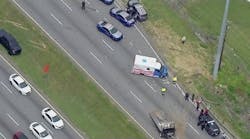Police Lt. Brian Strobele drew his service weapon and fired at a "mentally deranged" motorist, who had started backing up toward the lieutenant, who had gotten out of his patrol vehicle after a chase.
The bullet struck the driver of the pickup truck in the neck and shoulder, and Strobele believed he had saved not only himself but other South District officers.
Two years later, Strobele is one of a handful of Buffalo police officers facing departmental charges because of alleged improper use of deadly force.
Police brass say they are driving home the point that officers should not shoot at moving vehicles or put themselves in hazardous situations of their own making that cause them to shoot.
Department rules prohibit shooting at moving vehicles, except in extreme circumstances.
"Policies and procedures are in place for a reason. Officers must be held accountable and adhere to both," a high-ranking police official said, explaining that the disciplinary crackdown will result in safer conditions for the public and officers.
Strobele has been departmentally charged with improper use of force and shooting at a moving vehicle. At least two other officers have been administratively charged with shooting at different vehicles, and others are expected to be cited.
"I just want to let everyone know ... I was involved in a shooting a few years ago. ... The mentally unstable man driving could have killed me and several other officers ... and the city is bringing me up on charges for firing at a moving vehicle and other charges. ... Maybe I should have let him run me over. ... It would have been less painful than hearing that," Strobele wrote several days ago on a social media site when he found out about the pending charges.
The suspect he shot recovered and ended up pleading guilty to a reduced charge of reckless endangerment. He was sentenced to the city's Mental Health Court, where proceedings were completed earlier this year.
Taking officers to task on split-second decisions on whether to use deadly force, police officials say, might not be a popular move. But they say it is necessary, given a rash of police shootings involving vehicles in recent years.
Department policy on firing at vehicles states:
"The department members shall not discharge their firearms at or from a moving vehicle unless the member reasonably believes that the use of deadly physical force is necessary to protect the member or another person from the imminent use of deadly physical force by the suspect."
In 2012, city police officers shot eight times at vehicles, and in half of those incidents, four suspects were injured. A fifth incident last December involved a traffic stop that ended up claiming the life not only of the mortally wounded driver, but a pedestrian on the East Side.
Isaac C. Parker had been stopped by police who partially entered his sport utility vehicle and detected the smell of alcohol. Sensing Parker was about to drive away, one of the officers shot Parker. The officers managed to tumble out of the vehicle, which traveled about four-tenths of a mile before hitting three light poles. One of poles crashed on top of Ida Murphy, 54, and killed her.
Parker's blood-alcohol content was four times the legal limit, authorities later determined.
Attorney Thomas H. Burton, who represents police involved in deadly use-of-force cases, questions the department's disciplinary actions against officers who shot at suspects in vehicles. The unpredictable nature of police work and the propensity for violence among suspects, he said, often results in officers' having to set the rule book aside.
"In extreme cases of life-or-death situations, the procedures of the rules of defense trump procedures of the Police Department and any administrative policies," said Burton, who represented Strobele in the shooting.
"Desperate suspects," he said, will often try to use their vehicles as "deadly weapons," placing officers in situations "where they have no other option than to shoot."
Police officials, in arguing that gunfire against a moving vehicle is unnecessary, countered by saying it is unlikely that bullets will stop the motor vehicle and that officers should not have put themselves in the path of the vehicle.
"The theory is great, but traffic stops with a violent criminal can turn ugly in an instant," Burton said. "The challenge to a street cop is to balance self-preservation against not being reckless toward innocent citizens."
Police Officer Kevin M. Kennedy, president of the Buffalo Police Benevolent Association, the union representing officers, said he has yet to receive a copy of departmental charges in Strobele's case and could not comment.
Police Commissioner Daniel Derenda declined to comment, saying that pending police disciplinary cases are internal personnel matters and he is prohibited from discussing them.
The Erie County District Attorney's Office reviewed the Strobele case and to date has not presented it to the grand jury, Burton said.
The case involving the two officers in the deadly traffic stop last December, and the determination of whether criminal behavior occurred by the officers, is still under review by District Attorney Frank A. Sedita III.
Arlee Daniels Jr., program coordinator of the Stop the Violence Coalition in Buffalo, said the police force has generally done well in making sure officers follow safety procedures, though unfortunate situations have occurred.
"There have been some incidents where officers prematurely discharged their weapons while pursuing those they believed were in violation of the law, and that, in itself, is unacceptable, because it puts citizens and other pedestrians in harm's way when a weapon is discharged at a moving target," Daniels said.
Of the efforts to make sure officers follow department policies and procedures, he added, "It helps restore confidence between police and citizens that nothing will be swept under the rug to cover up misconduct of law enforcement."
Copyright 2013 - The Buffalo News, N.Y.
McClatchy-Tribune News Service


